Not content with visiting the Ceramics Biennale at Icheon, we made trips to both Gwangju and Yeoju sites to get the full expo experience.
At Gwangju the major exhibition was from the Topkapi Museum in Istanbul and showed Chinese and Turkish ceramics from the collection.
At Yeoju we saw the other half of the competition "Ceramics for Use". The Bat took the camera off me and photographed all of her favourites. She enjoyed the works of art so much that she has now created her own blog to show off the photos. Click on over to Blog-bat.blogspot.com to see the 40 photos we've uploaded.
Sunday, May 27, 2007
Tuesday, May 22, 2007
Lotus Lantern Festival Seoul
After meeting the authors of The Korean Way of Tea we walked the short distance to the Jogyesa temple. It was colourfully decorated with thousands of lanterns for Buddha's birthday celebrations.
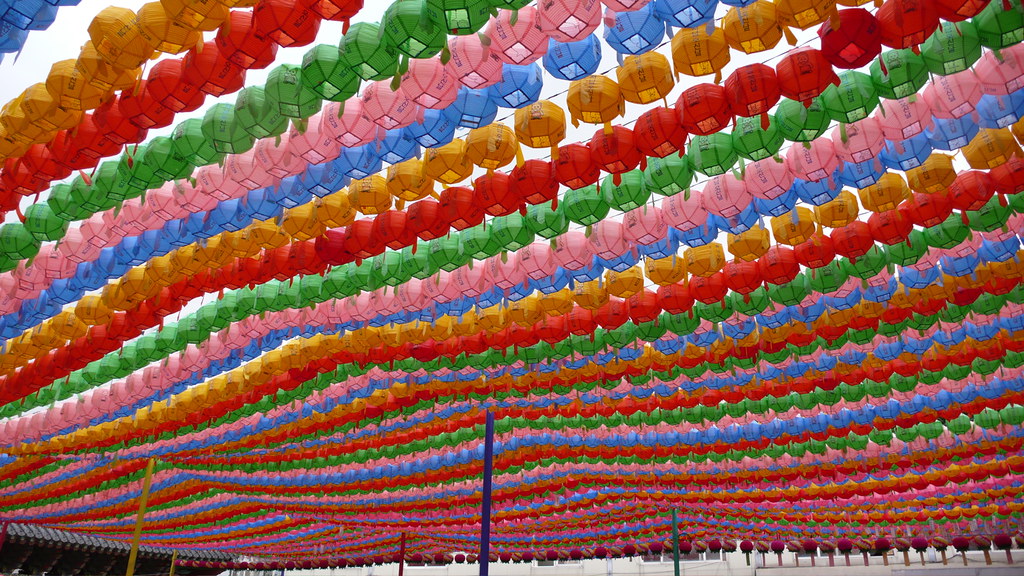
These small children drew a lot of attention, they look so grown up in their buddhist monk's robes, but they were still very playful.
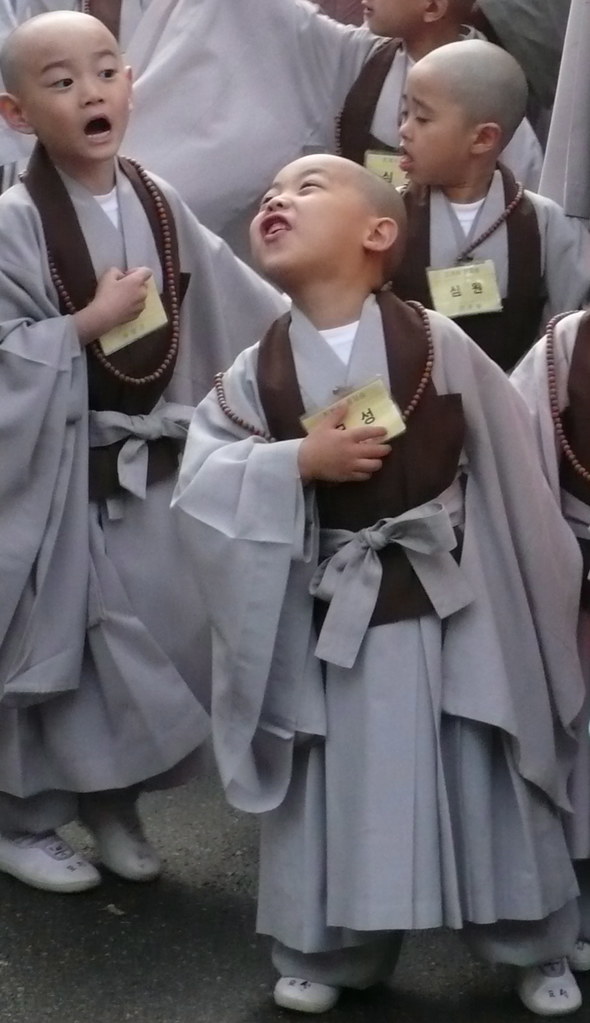
There were two parades during the weekend festival. On Saturday there was a short parade from Jogyesa through Insadong along Jongro to a temporary stage setup on the road near Jongak station.
These were some of the participants :
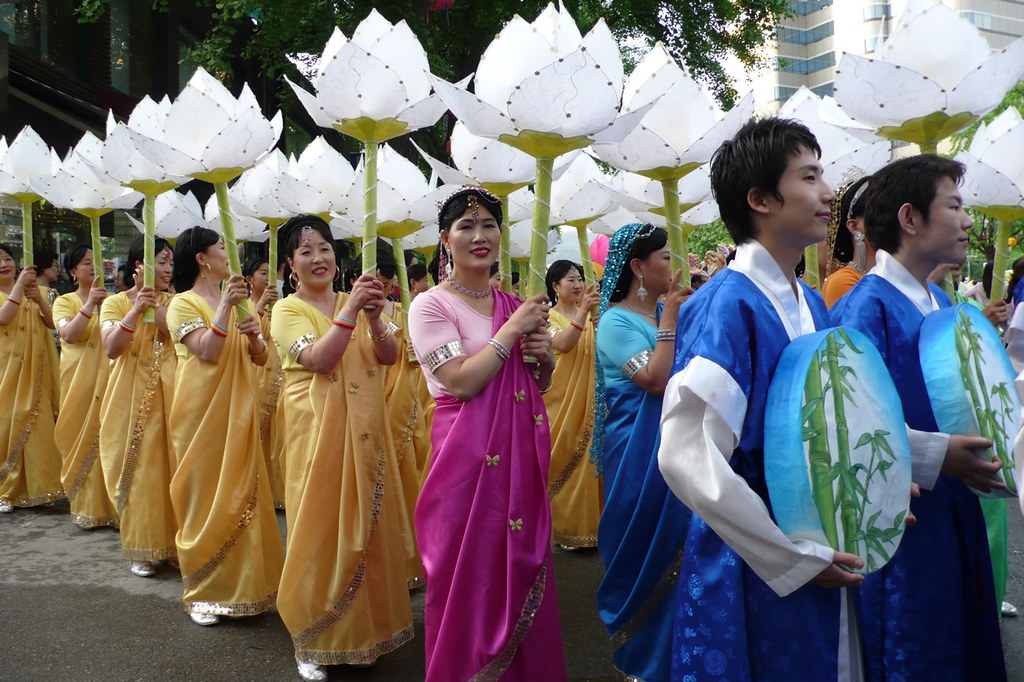
One of the floats in the parade.
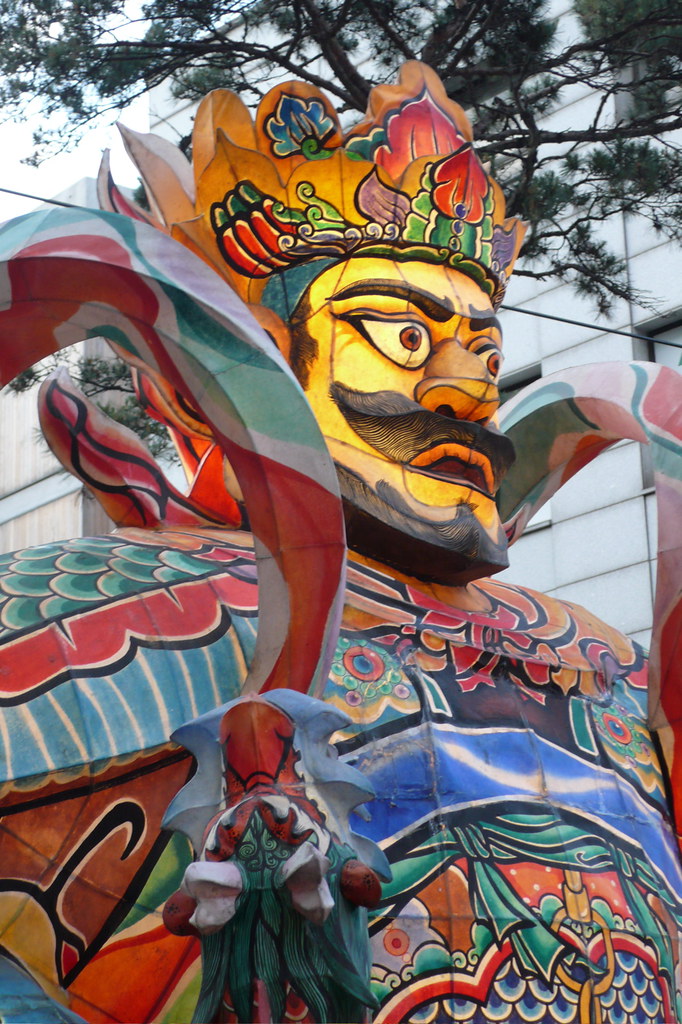
On the Sunday was an even more spectacular and longer parade. We went to Dongdaemun stadium to watch the opening ceremony. The entire crowd seemed to be part of the parade and festival. There was much singing and dancing and crowd participation.

The parade started at 6:30pm and continued until 9:40 pm.
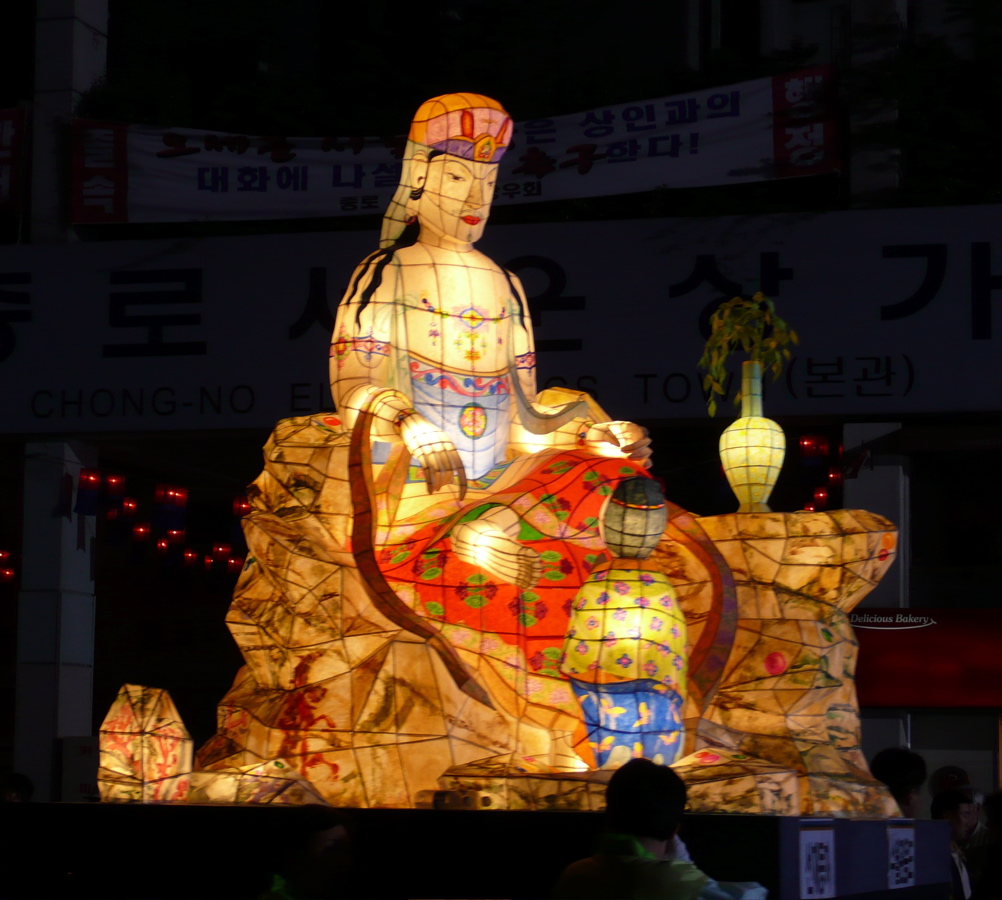
These two young children look like they had had enough fun at the festival, it was around 9:30pm when they went past us.
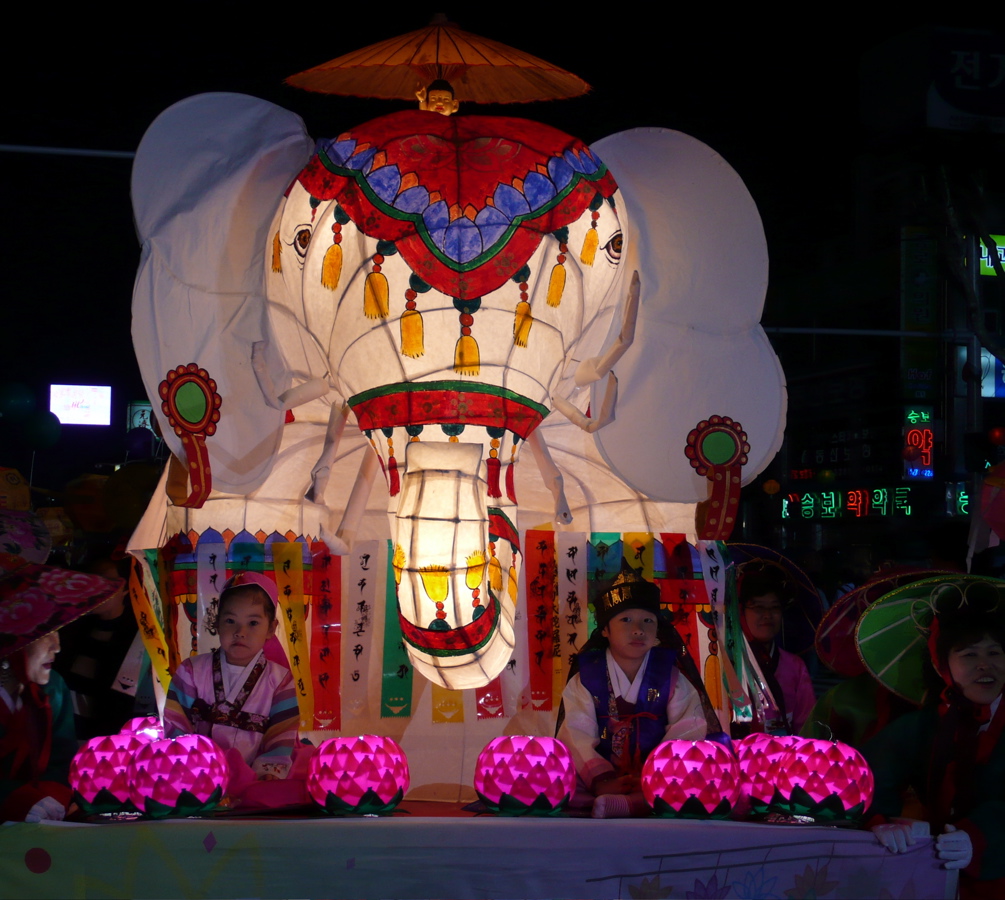
This was one of my favourite floats
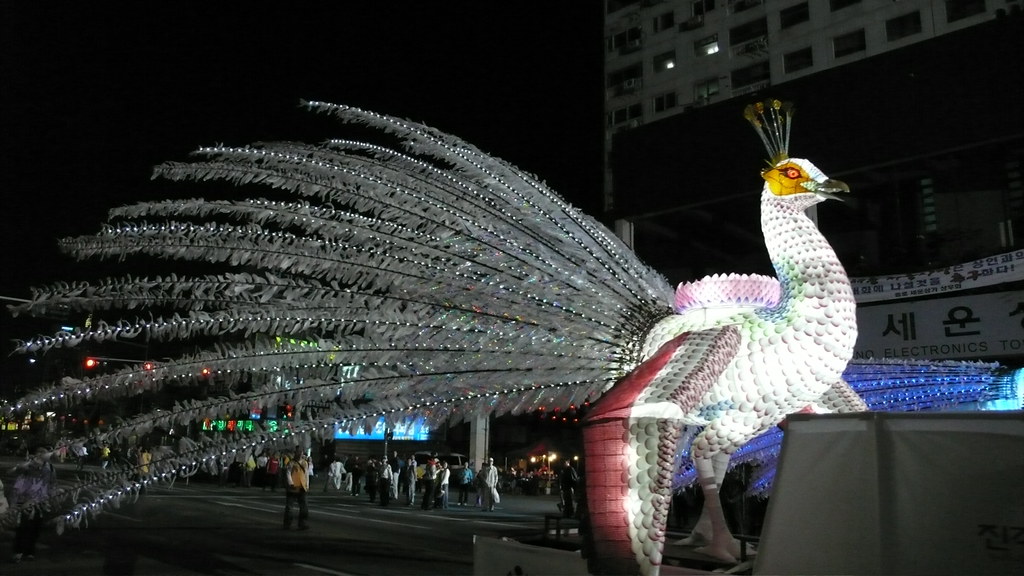
and this was the back of it after it went past.
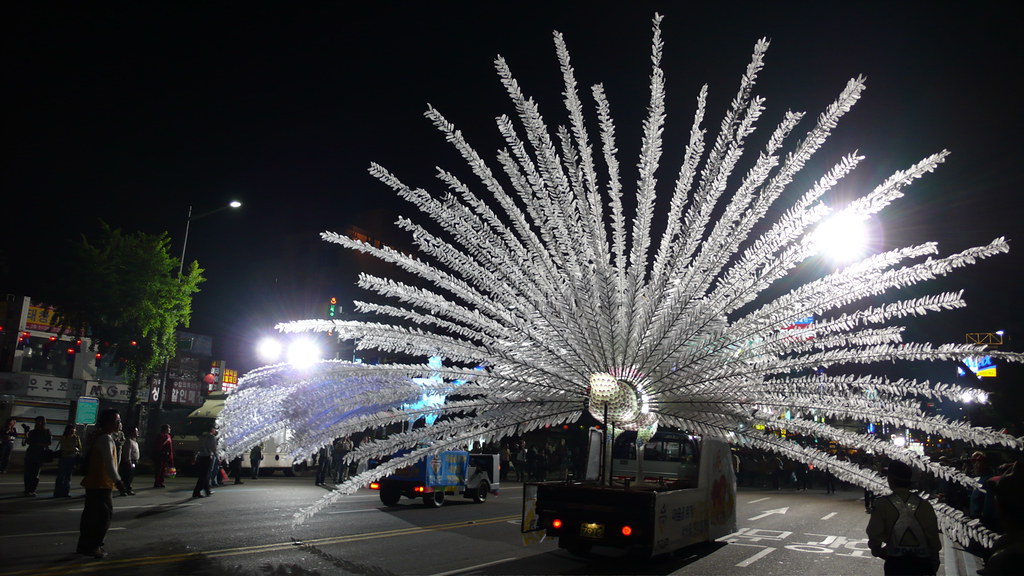
Sam has lots more photos of the event here and here.

These small children drew a lot of attention, they look so grown up in their buddhist monk's robes, but they were still very playful.

There were two parades during the weekend festival. On Saturday there was a short parade from Jogyesa through Insadong along Jongro to a temporary stage setup on the road near Jongak station.
These were some of the participants :

One of the floats in the parade.

On the Sunday was an even more spectacular and longer parade. We went to Dongdaemun stadium to watch the opening ceremony. The entire crowd seemed to be part of the parade and festival. There was much singing and dancing and crowd participation.

The parade started at 6:30pm and continued until 9:40 pm.

These two young children look like they had had enough fun at the festival, it was around 9:30pm when they went past us.

This was one of my favourite floats

and this was the back of it after it went past.

Sam has lots more photos of the event here and here.
Sunday, May 20, 2007
The Korean Way of Tea
Seoul Selection have recently published a small but perfectly formed book entitled 'The Korean Way of Tea, An Introductory Guide' by Brother Anthony of Taizé and Hong Kyeong-Hee. It is the first English language book written specifically about Korean tea.
We had the pleasure of meeting the two authors and sharing some Korean tea with them at an event to celebrate the new work at Seoul Selection bookshop near Gyeongbokgung. Here are the authors, Brother Anthony in the foreground.
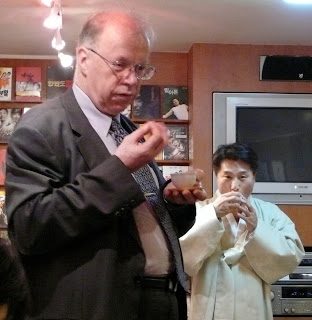
Brother Anthony is an Englishman who came to Korea in 1980 and became interested in Korean tea after tasting the finest hand dried Korean tea in the idyllic setting of a traditional Korean house on the southern slopes of Jiri mountain.
The book describes the labour intensive process of picking, parching, rolling, separating and drying the shoots of the Camellia sinensis (tea) bush. The Korean tea ceremony and the utensils used are explained in easy to follow steps. 'The History of Tea in China' and 'How Tea came the West' are also covered in brief but detailed and well researched chapters.

Preparation for the book lasted a year and began in May 2006 at the start of the tea picking season when many of the photographs were taken.
Although it presents itself as an introductory guide, the information presented is precise and very well written and the authors' enthusiasm for their subject shines through. The meditative (seon or zen) aspects of tea are touched upon often, and overall style, illustration and poetry all contribute to creating a book that is a wonderful companion for a quiet pause. Just like a delicious cup of tea.
The 124 page softback book costs 12,000 won, available from Seoul Selection and local bookshops.
Brother Anthony has a homepage with more details of his other books and interests.
We had the pleasure of meeting the two authors and sharing some Korean tea with them at an event to celebrate the new work at Seoul Selection bookshop near Gyeongbokgung. Here are the authors, Brother Anthony in the foreground.

Brother Anthony is an Englishman who came to Korea in 1980 and became interested in Korean tea after tasting the finest hand dried Korean tea in the idyllic setting of a traditional Korean house on the southern slopes of Jiri mountain.
The book describes the labour intensive process of picking, parching, rolling, separating and drying the shoots of the Camellia sinensis (tea) bush. The Korean tea ceremony and the utensils used are explained in easy to follow steps. 'The History of Tea in China' and 'How Tea came the West' are also covered in brief but detailed and well researched chapters.

Preparation for the book lasted a year and began in May 2006 at the start of the tea picking season when many of the photographs were taken.
Although it presents itself as an introductory guide, the information presented is precise and very well written and the authors' enthusiasm for their subject shines through. The meditative (seon or zen) aspects of tea are touched upon often, and overall style, illustration and poetry all contribute to creating a book that is a wonderful companion for a quiet pause. Just like a delicious cup of tea.
The 124 page softback book costs 12,000 won, available from Seoul Selection and local bookshops.
Brother Anthony has a homepage with more details of his other books and interests.
Thursday, May 17, 2007
From Seoul to Beijing by Train?
Well, not just yet. But today's historic test run of two trains between North and South Korea is a step in the right direction.
While South Korea is geographically on a peninsula, logistically it is an island. The last trains to cross the border were in the 1950's. (A fact unknown to more than one Lonely Planet traveller)
Today at two locations diesel trains crossed the heavily fortified Military Demarcation Line between the two countries. The two trains carried a total of 300 carefully selected passengers in each train, 100 from the south and 50 from the north.
In the eastern section, the train departed from Kumgangsan Station in the North for the South's Jejin Station on a 25.5-kilometer track. The other train left Munsan Station in the South bound for Kaesong Station in the North on a 27.3-kilometer track in the western section.
The event, including speeches by ministers from both countries was covered live on four major TV stations this lunchtime.
Initial hopes are for regular trains to start carrying workers to the industrial centre at Kaesong, and for tourists to be able to use the trains for visiting Mount Kumgang in the east, in place of the existing bus route. No North Korean visitors to the South would be expected, I guess.
Meanwhile, the railway between the North Korean port of Najin and the Russian town of Khasan is being eyed up for repairs and improvement by the Russians, who would like to develop the port into a logistics hub and and future oil and gas terminal. The port is also close to the Chinese border and Beijing has promised Pyongyang $1 billion to improve the port and the railway as well.
According to Senior Executive Director of Korail, 2008 is the target for introduction of through-trains between Seoul and China. This would, of course, require the co-operation of the North Koreans, who already run through-trains from China to Pyongyang.
That target seems a little optimistic to me, considering how long these tests have taken to agree, however, I can foresee the possibility of the introduction of freight trains along the route at some point in the future. That should reduce transportation costs for South Korean exporters. Maybe one day the station at Dorasan will see some cross border passengers.
News links : Yonhap , BBC (including video) , KBS , NY Times , Yahoo News , MBN (in Korean, but with video), Hankyoreh , Australian News, and a recent strong editorial from the Chosun Ilbo.
While South Korea is geographically on a peninsula, logistically it is an island. The last trains to cross the border were in the 1950's. (A fact unknown to more than one Lonely Planet traveller)
Today at two locations diesel trains crossed the heavily fortified Military Demarcation Line between the two countries. The two trains carried a total of 300 carefully selected passengers in each train, 100 from the south and 50 from the north.
In the eastern section, the train departed from Kumgangsan Station in the North for the South's Jejin Station on a 25.5-kilometer track. The other train left Munsan Station in the South bound for Kaesong Station in the North on a 27.3-kilometer track in the western section.
The event, including speeches by ministers from both countries was covered live on four major TV stations this lunchtime.
Initial hopes are for regular trains to start carrying workers to the industrial centre at Kaesong, and for tourists to be able to use the trains for visiting Mount Kumgang in the east, in place of the existing bus route. No North Korean visitors to the South would be expected, I guess.
Meanwhile, the railway between the North Korean port of Najin and the Russian town of Khasan is being eyed up for repairs and improvement by the Russians, who would like to develop the port into a logistics hub and and future oil and gas terminal. The port is also close to the Chinese border and Beijing has promised Pyongyang $1 billion to improve the port and the railway as well.
According to Senior Executive Director of Korail, 2008 is the target for introduction of through-trains between Seoul and China. This would, of course, require the co-operation of the North Koreans, who already run through-trains from China to Pyongyang.
That target seems a little optimistic to me, considering how long these tests have taken to agree, however, I can foresee the possibility of the introduction of freight trains along the route at some point in the future. That should reduce transportation costs for South Korean exporters. Maybe one day the station at Dorasan will see some cross border passengers.
News links : Yonhap , BBC (including video) , KBS , NY Times , Yahoo News , MBN (in Korean, but with video), Hankyoreh , Australian News, and a recent strong editorial from the Chosun Ilbo.
Swimming with the fishes in Yulpo
This post completes the details of our trip. (See part 1, part 2)
We left Mokpo and drove to nearby Wolchulsan National Park. We stayed at the hotel there close to the Dogapsa entrance.
We enjoyed a quiet walk in the park the next day before heading off for the nearby Yongam pottery centre. We found the kiln and a gift shop in the very pretty village of Gurim, but despite the shop keeper's attempt at giving us directions, we were unable to find the pottery centre. The village must be one of the most attractive we've seen in Korea, with a small area of traditional houses and stone bridges over the stream.
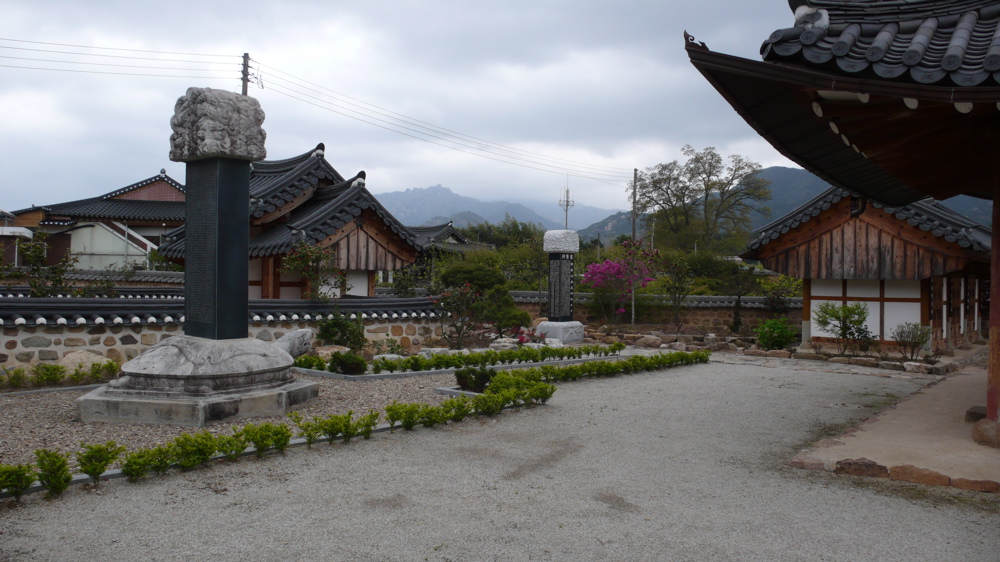
We headed south to another pottery centre at Gangjin. This was much easier to find as it was marked on our map! The site includes another traditional wood-burning kiln, many shops and a museum housed in two large buildings.
Note the porcelain tile wall on the exterior of the museum and the large pot in the foreground

Here is the traditional wood-burning kiln. Used to make royal celadon ware for centuries.


The first museum displayed mostly potsherds of Korean celadon (blue-green) porcelain with just a few explanations in English; it was a little disappointing, the second museum had a special exhibition of around thirty pieces from the Limoges region of France and a selection of modern Korean and Chinese ceramics.
Here is a very fine modern piece from China

The grounds around the museum are scattered with large pieces of original celadon, each worth a considerable amount. Here is a celadon fountain with perhaps 13 individual porcelain pieces.

Leaving Gangjin we drove around the headland and arrived in Yulpo. We inquired at the huge Yulpo Spa resort about the cost of a room. 248,000 won was a trifle above our budget, we'd been paying maximum 50,000 won up until now, so we drove a few hundred meters back into town and found a minbak beside the SK petrol station, above a restaurant, for 40,000 won instead.
We were in green-tea country, just a few kilometers south of the main tea-producing area in Boseong, and so everything had a green-tea theme. That evening I sampled the delights of green-tea-pork, which is a local speciality, but I couldn't tell the difference between that and the normal Samgyeopsal I've had back in Seoul.
Yulpo Spa is run by the local council and is open to the public daily from 6am to 8pm; the spa is best known for Yulpo Haesu Nogchatang ( seawater and green-tea bath ) though it offers much more than this. The spa occupies 4 floors and offers views of Yulpo Bay from the baths and from the open area on the top floor. Visitors may don yellow-earth-impregnated kit and wander about the very spacious, warm facilities luxuriating in a sense of Korean "well-being", to use the industry jargon. Yellow earth is very well-known in Korea and China for its healthy properties.
The next morning we returned to Yulpo Spa, we paid the 5,000 won entrance fee and separated to go to our respective gender's saunas. I was relaxing in one of the hot pools when one of the attendants came around asking for a "Mister Jon". I was the only westener, so he found me fairly easily and led me back into the changing area and indicated I should put on some shorts and a T-shirt he proffered. He then led me upstairs to the fourth floor and a large pond filled with green tea and thousands of small fishes!
The Bat joined me and explained that she'd gone exploring, found this treatment area available to both sexes, and she'd paid an extra 5,000 won each for the experience called 'Doctor Fish'. The idea is that you sit in the pool wearing a bathing costume, exposing as much flesh as you wish, and these small garra rufa fish gently nibble at your dead skin and revitalise it. Personally I found it was very tickly and a bit too high on the 'ick' factor for my liking, but apparently for psoriasis suffers it does offer some relief.
Dr Fish is also available in Icheon at the Termeden Spa we discovered later [Infact visitors to the Ceramics expo can get a 30% discount off the entrance fee to the spa. Pick up a voucher at their stand at the fair] , and The Guardian had a report on it at a spa in Ireland too. It's got a great photo of what to expect. If you go to Yulpo, make sure to ask for 'Doctor Fish' at reception as there are no posters or information at the cash desk. There are two other saunas in the treatment area, one with hot pebbles and one with hot quartz rocks to lie on, both were very pleasant indeed.
Suitably refreshed we continued our journey north. For the last night of our trip we stayed just outside Deogyusan National Park in another minbak. The small village near the Anseong entrance was very quiet, almost deserted, we found out the next morning this was because the route into the park here was closed temporarily. There was nothing in English on the sign, but I believe this restriction was due to the risk of fires at this time of year.
We drove around the park towards another entrance, but this time, rather than use one of the major paths available from the ticket booth, we chose a road leading into the park that was shown as petering out to a dead end. We parked at the end of the tarmac and continued on foot on a small path past the cultivated area up into the woods. This approach gave us the least disturbed visit to a national park we have ever experienced. The path was a little more difficult to follow and a little overgrown but we met no-one once we passed the ginseng (Korean "insam") field at the head of the valley. The scenery was a lush green and the wildlife was much more in evidence than on other national park trips.
Gentians ( Gentiana sp.) are generally alpines but here they were at low altitude in Deogyusan.

From there we drove back to Seoul along the expressway.
Some observations on our trip:
We left Mokpo and drove to nearby Wolchulsan National Park. We stayed at the hotel there close to the Dogapsa entrance.
We enjoyed a quiet walk in the park the next day before heading off for the nearby Yongam pottery centre. We found the kiln and a gift shop in the very pretty village of Gurim, but despite the shop keeper's attempt at giving us directions, we were unable to find the pottery centre. The village must be one of the most attractive we've seen in Korea, with a small area of traditional houses and stone bridges over the stream.

We headed south to another pottery centre at Gangjin. This was much easier to find as it was marked on our map! The site includes another traditional wood-burning kiln, many shops and a museum housed in two large buildings.
Note the porcelain tile wall on the exterior of the museum and the large pot in the foreground

Here is the traditional wood-burning kiln. Used to make royal celadon ware for centuries.


The first museum displayed mostly potsherds of Korean celadon (blue-green) porcelain with just a few explanations in English; it was a little disappointing, the second museum had a special exhibition of around thirty pieces from the Limoges region of France and a selection of modern Korean and Chinese ceramics.
Here is a very fine modern piece from China

The grounds around the museum are scattered with large pieces of original celadon, each worth a considerable amount. Here is a celadon fountain with perhaps 13 individual porcelain pieces.

Leaving Gangjin we drove around the headland and arrived in Yulpo. We inquired at the huge Yulpo Spa resort about the cost of a room. 248,000 won was a trifle above our budget, we'd been paying maximum 50,000 won up until now, so we drove a few hundred meters back into town and found a minbak beside the SK petrol station, above a restaurant, for 40,000 won instead.
We were in green-tea country, just a few kilometers south of the main tea-producing area in Boseong, and so everything had a green-tea theme. That evening I sampled the delights of green-tea-pork, which is a local speciality, but I couldn't tell the difference between that and the normal Samgyeopsal I've had back in Seoul.
Yulpo Spa is run by the local council and is open to the public daily from 6am to 8pm; the spa is best known for Yulpo Haesu Nogchatang ( seawater and green-tea bath ) though it offers much more than this. The spa occupies 4 floors and offers views of Yulpo Bay from the baths and from the open area on the top floor. Visitors may don yellow-earth-impregnated kit and wander about the very spacious, warm facilities luxuriating in a sense of Korean "well-being", to use the industry jargon. Yellow earth is very well-known in Korea and China for its healthy properties.
The next morning we returned to Yulpo Spa, we paid the 5,000 won entrance fee and separated to go to our respective gender's saunas. I was relaxing in one of the hot pools when one of the attendants came around asking for a "Mister Jon". I was the only westener, so he found me fairly easily and led me back into the changing area and indicated I should put on some shorts and a T-shirt he proffered. He then led me upstairs to the fourth floor and a large pond filled with green tea and thousands of small fishes!
The Bat joined me and explained that she'd gone exploring, found this treatment area available to both sexes, and she'd paid an extra 5,000 won each for the experience called 'Doctor Fish'. The idea is that you sit in the pool wearing a bathing costume, exposing as much flesh as you wish, and these small garra rufa fish gently nibble at your dead skin and revitalise it. Personally I found it was very tickly and a bit too high on the 'ick' factor for my liking, but apparently for psoriasis suffers it does offer some relief.
Dr Fish is also available in Icheon at the Termeden Spa we discovered later [Infact visitors to the Ceramics expo can get a 30% discount off the entrance fee to the spa. Pick up a voucher at their stand at the fair] , and The Guardian had a report on it at a spa in Ireland too. It's got a great photo of what to expect. If you go to Yulpo, make sure to ask for 'Doctor Fish' at reception as there are no posters or information at the cash desk. There are two other saunas in the treatment area, one with hot pebbles and one with hot quartz rocks to lie on, both were very pleasant indeed.
Suitably refreshed we continued our journey north. For the last night of our trip we stayed just outside Deogyusan National Park in another minbak. The small village near the Anseong entrance was very quiet, almost deserted, we found out the next morning this was because the route into the park here was closed temporarily. There was nothing in English on the sign, but I believe this restriction was due to the risk of fires at this time of year.
We drove around the park towards another entrance, but this time, rather than use one of the major paths available from the ticket booth, we chose a road leading into the park that was shown as petering out to a dead end. We parked at the end of the tarmac and continued on foot on a small path past the cultivated area up into the woods. This approach gave us the least disturbed visit to a national park we have ever experienced. The path was a little more difficult to follow and a little overgrown but we met no-one once we passed the ginseng (Korean "insam") field at the head of the valley. The scenery was a lush green and the wildlife was much more in evidence than on other national park trips.
Gentians ( Gentiana sp.) are generally alpines but here they were at low altitude in Deogyusan.

From there we drove back to Seoul along the expressway.
Some observations on our trip:
- It does not have to take three days to get to Jindo, you can get a bus from Seoul, it takes about six hours, but we decided to take the scenic route and see more of the country on the way down.
- All the locations we visited can be reached by public transport. The Lonely Planet guide book has detailed instructions for this.
- The best places to find small hotels and minbak (rooms for rent in private houses) are near the serice areas of the national and provincial parks. It's a good idea to learn the Korean for minbak as most of them do not have signs in English. The owners are unlikely to speak English, but with sign language we had no problems.
- For good places to eat look out for the 'Good Restaurant' sign, we've not been let down by any establishment showing this sign.
- The road atlas we used is published by the Jungang Atlas Co. Their website is Korean only, but the atlas has most place names in English and Korean. Available in bookshops for 12,000 won.
- The National Parks Authority publishes a guidebook for the National Parks of Korea. It includes maps and photos of all twenty parks. The maps do not have any detail of the area outside the park boundary, but are very useful for deciding which entrance to aim for at each park. Available in large bookshops and some park offices for 10,000 won.
Monday, May 14, 2007
The 4th World Ceramic Biennale
Continuing my theme of festivals worth visiting, we visited the Ceramics World Exposition in Icheon last week.
We took the bus from the Express Bus terminal in Seoul, as suggested on both the KNTO site and the wocef site, to Icheon Bus terminal, a 90 minute journey south from Seoul. On arrival there were no signs indicating the location of the event, luckily the taxi driver understood the word EXPO and dropped us off at the event in less than 5 minutes.
The Expo site is in a valley surrounded by woods and bounded by a man-made lake at the valley mouth. Four temporary gallery areas provide hundreds of artists space to display and sell their ceramic wares. Objects for sale range from small items of jewelry for a few thousand won, to large intricate open-ware celadon vases going for 35 million won. A huge variety of sizes, shapes and colours of plates, vases and decorative pieces were on show.
Walking up the slope we walked through a gallery in the shape of a traditional wood fired kiln. It contained examples and details on the history of ceramics on the peninsula and in Asia in general.
At the head of the valley is the permanent exhibition hall, entrance fee 5,000 won. On the ground floor were seventy entries in the 'Ceramics for expression' half of the competition. Over 2,400 objects from artists around the world were submitted to the competition in two categories. The shortlisted items for the other half 'Ceramics for use' are exhibited at the expo site in Yeoju.
On our way out, the English speaking member of staff stopped us to ask a few questions about our visit to the Expo. She was most distressed to hear that we had not known of a shuttle bus service from Seoul to the Expo. When we showed her the printouts from the websites she promised to get them updated. In the meantime here is a scan of the timetable with our translations on it.

The top list is for the bus from near the Coex mall to Gwangju and back, the second list is from Insa-dong to Icheon and back and final list shows the one bus a day from Insa-dong to Yeoju and back.
She also explained the two other sites for the expo Gwanju and Yeoju are both within 30 minutes drive from Icheon, we originally thought Gwanju was the city in Jellonam-do , four hours drive south of Seoul, but the one you want is in Gyeonggi-do, much closer!
The exhibition closed at 6pm and after a meal at the excellent food court and a walk around the lake that includes the obligatory sculpture garden, we boarded the shuttle bus for Insa-dong for the trip back to Seoul.
The Expo only takes place once every two years and even if you don't think pots are really your thing, I still highly recommend a trip to the event to see the creativity on display there before it ends on May 27th.
I had a day off from photography, which is probably a good thing otherwise I could probably have taken several hundred shots of the weird and wonderful works of art, instead I'll leave you with a shot of four of the winners

courtesy of a Korean site.
We took the bus from the Express Bus terminal in Seoul, as suggested on both the KNTO site and the wocef site, to Icheon Bus terminal, a 90 minute journey south from Seoul. On arrival there were no signs indicating the location of the event, luckily the taxi driver understood the word EXPO and dropped us off at the event in less than 5 minutes.
The Expo site is in a valley surrounded by woods and bounded by a man-made lake at the valley mouth. Four temporary gallery areas provide hundreds of artists space to display and sell their ceramic wares. Objects for sale range from small items of jewelry for a few thousand won, to large intricate open-ware celadon vases going for 35 million won. A huge variety of sizes, shapes and colours of plates, vases and decorative pieces were on show.
Walking up the slope we walked through a gallery in the shape of a traditional wood fired kiln. It contained examples and details on the history of ceramics on the peninsula and in Asia in general.
At the head of the valley is the permanent exhibition hall, entrance fee 5,000 won. On the ground floor were seventy entries in the 'Ceramics for expression' half of the competition. Over 2,400 objects from artists around the world were submitted to the competition in two categories. The shortlisted items for the other half 'Ceramics for use' are exhibited at the expo site in Yeoju.
On our way out, the English speaking member of staff stopped us to ask a few questions about our visit to the Expo. She was most distressed to hear that we had not known of a shuttle bus service from Seoul to the Expo. When we showed her the printouts from the websites she promised to get them updated. In the meantime here is a scan of the timetable with our translations on it.

The top list is for the bus from near the Coex mall to Gwangju and back, the second list is from Insa-dong to Icheon and back and final list shows the one bus a day from Insa-dong to Yeoju and back.
She also explained the two other sites for the expo Gwanju and Yeoju are both within 30 minutes drive from Icheon, we originally thought Gwanju was the city in Jellonam-do , four hours drive south of Seoul, but the one you want is in Gyeonggi-do, much closer!
The exhibition closed at 6pm and after a meal at the excellent food court and a walk around the lake that includes the obligatory sculpture garden, we boarded the shuttle bus for Insa-dong for the trip back to Seoul.
The Expo only takes place once every two years and even if you don't think pots are really your thing, I still highly recommend a trip to the event to see the creativity on display there before it ends on May 27th.
I had a day off from photography, which is probably a good thing otherwise I could probably have taken several hundred shots of the weird and wonderful works of art, instead I'll leave you with a shot of four of the winners

courtesy of a Korean site.
Thursday, May 10, 2007
The Top 5 festivals in Seoul
It seems spring is the best time of year for festivals in Seoul. Here's my personal top 5 festivals in the capital city.
1. The Cherry Blossom Festival
The sight of hundreds of Cherry trees all in blossom along the road around the National Assembly building in Yeouido was an especially beautiful spectacle. My photos are here and here, more photos of blossom in Korea from contributors to the flickr Korean Images group.
2. Hi Seoul Festival
I've already posted a couple of items on the festival that took place over eight days at the start of this month. There was the High Wire competition and the drumming and Taekwondo at Gyeonghuigung palace. Here's a one minute recording of the energetic female drumming group from that day
I've also posted on youtube a two minute clip of the drumming from the Non verbal Performance we watched. Here's a shot of the illuminated boats departing their mooring at Seonyudo park:
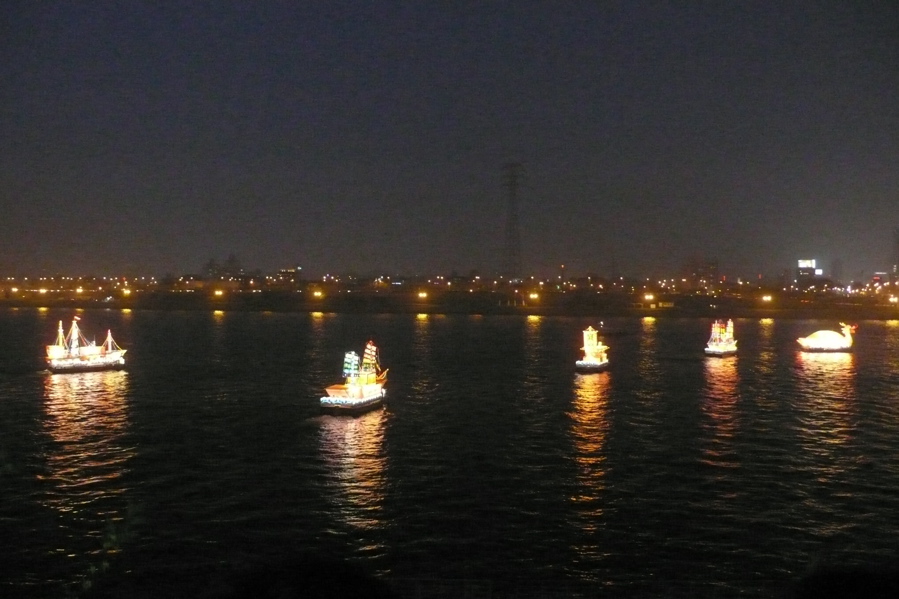 On the Saturday afternoon was the re-enactment of the coronation of King Sejong. This event took place in the Gyeongbok palace. Here's a couple of photos of some of the dancers preparing to go on stage.
On the Saturday afternoon was the re-enactment of the coronation of King Sejong. This event took place in the Gyeongbok palace. Here's a couple of photos of some of the dancers preparing to go on stage.
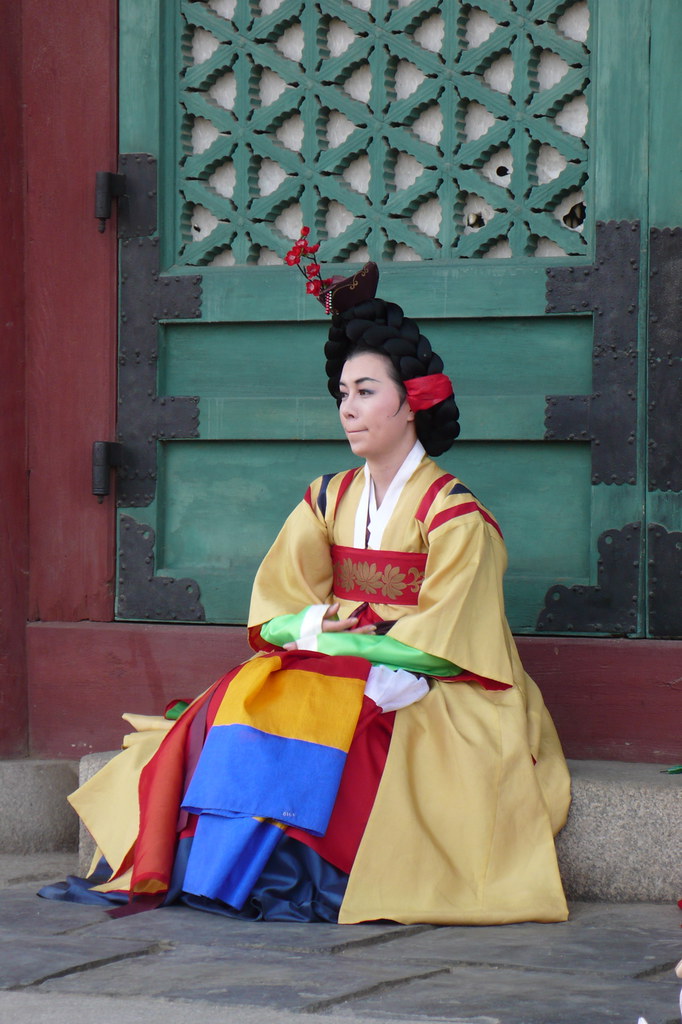

If you were at the Hi Seoul Festival and took a good photo, the organisers are running a photo and video contest with cash prizes, hurry the competition closes on May 13th.
3. Jongmyo Daeje
This spectacular parade and sombre and ancient ritual was a fascinating experience. Erkin was with us that day and has some great photos on his blog.
4. Lotus Lantern Festival for Buddha's birthday
The festival is happening during the next few weeks. There are a number of events occurring in and around Seoul and at temples throughout South Korea leading up to Buddha's birthday on May 24th. I'll be busy photographing that this month. More details at the Lotus Lantern Festival site.
5. Seokjeondaeje
Seokjeondaeje Memorial Rite is one of Korea's most important sacred rituals in Confucianism. It takes place at the Confucius Shrine (Daeseongjeon Hall) at Sungkyunkwan University twice a year in March and September.
This one I've had the most problems finding out about. There is a video of it here and hints and notes about it at several travel websites and a reference here, but no firm details. The Sungkyunkwan University website does not even mention it. I will have to report back on this one later.
Some upcoming events in Seoul are:
The Korea International Arts fair at the COEX Mall. The show includes over 5,000 works of art and runs until Sunday.
The Green Film festival starts May 17th featuring 112 films from 23 countries.
The Biggest K-Rock festival ever starts on the same day. If the names Boohwal, Black Hole, Black Syndrome, The Rock Tigers, Crying Nut and Peter Pan Complex mean anything to you then I'm sure you already know that the venue is the Seoul Fashion and Art Hall located in the middle of Dongdaemun. Ten rock groups will perform each night for the 10-day festival from 8 p.m. to 2 a.m. between May 17-26.
There are plenty more festivals throughout the country during the year including the Firefly festival in Muju, The Busan Film Festival (the Cannes of Korea), The Boryeong Mud festival in July, which is popular with ESL teachers, The Chuncheon International Mime Festival is on at the end of this month, and the Hadong Wild Tea Festival is coming up this weekend. Check out the KNTO and Invil village websites for more festivals.
This post is a contribution to the pro-blogger Group Writing Project organised by Darren Rowse. Check out the hundreds of other entries from day 1 and day 2 that bloggers around the world have posted on the topic of 'Top 5'. All manner of subjects from Top 5 music video parodies to Top 5 techniques for sermon idea generation are covered.
1. The Cherry Blossom Festival
The sight of hundreds of Cherry trees all in blossom along the road around the National Assembly building in Yeouido was an especially beautiful spectacle. My photos are here and here, more photos of blossom in Korea from contributors to the flickr Korean Images group.
2. Hi Seoul Festival
I've already posted a couple of items on the festival that took place over eight days at the start of this month. There was the High Wire competition and the drumming and Taekwondo at Gyeonghuigung palace. Here's a one minute recording of the energetic female drumming group from that day
I've also posted on youtube a two minute clip of the drumming from the Non verbal Performance we watched. Here's a shot of the illuminated boats departing their mooring at Seonyudo park:
 On the Saturday afternoon was the re-enactment of the coronation of King Sejong. This event took place in the Gyeongbok palace. Here's a couple of photos of some of the dancers preparing to go on stage.
On the Saturday afternoon was the re-enactment of the coronation of King Sejong. This event took place in the Gyeongbok palace. Here's a couple of photos of some of the dancers preparing to go on stage.

If you were at the Hi Seoul Festival and took a good photo, the organisers are running a photo and video contest with cash prizes, hurry the competition closes on May 13th.
3. Jongmyo Daeje
This spectacular parade and sombre and ancient ritual was a fascinating experience. Erkin was with us that day and has some great photos on his blog.
4. Lotus Lantern Festival for Buddha's birthday
The festival is happening during the next few weeks. There are a number of events occurring in and around Seoul and at temples throughout South Korea leading up to Buddha's birthday on May 24th. I'll be busy photographing that this month. More details at the Lotus Lantern Festival site.
5. Seokjeondaeje
Seokjeondaeje Memorial Rite is one of Korea's most important sacred rituals in Confucianism. It takes place at the Confucius Shrine (Daeseongjeon Hall) at Sungkyunkwan University twice a year in March and September.
This one I've had the most problems finding out about. There is a video of it here and hints and notes about it at several travel websites and a reference here, but no firm details. The Sungkyunkwan University website does not even mention it. I will have to report back on this one later.
Some upcoming events in Seoul are:
The Korea International Arts fair at the COEX Mall. The show includes over 5,000 works of art and runs until Sunday.
The Green Film festival starts May 17th featuring 112 films from 23 countries.
The Biggest K-Rock festival ever starts on the same day. If the names Boohwal, Black Hole, Black Syndrome, The Rock Tigers, Crying Nut and Peter Pan Complex mean anything to you then I'm sure you already know that the venue is the Seoul Fashion and Art Hall located in the middle of Dongdaemun. Ten rock groups will perform each night for the 10-day festival from 8 p.m. to 2 a.m. between May 17-26.
There are plenty more festivals throughout the country during the year including the Firefly festival in Muju, The Busan Film Festival (the Cannes of Korea), The Boryeong Mud festival in July, which is popular with ESL teachers, The Chuncheon International Mime Festival is on at the end of this month, and the Hadong Wild Tea Festival is coming up this weekend. Check out the KNTO and Invil village websites for more festivals.
This post is a contribution to the pro-blogger Group Writing Project organised by Darren Rowse. Check out the hundreds of other entries from day 1 and day 2 that bloggers around the world have posted on the topic of 'Top 5'. All manner of subjects from Top 5 music video parodies to Top 5 techniques for sermon idea generation are covered.
Wednesday, May 09, 2007
New Korea ESL jobs listing service
This new site, Restohof, is a compilation of ESL jobs in Korea. What’s different about this site is the fact that people can vote and leave comments under each listing, which gives job seekers an idea of what they may be getting into.
Jobs are culled from three different sites currently : Dave's ESL Café,
the ESL Teacher’s Board and Seoul Craigslist.
If you are interested in coming over to Korea to teach English as a second language, check it out, as there are one or two private language schools (hagwons) you may not want to work for out there. Read the story of Joe, the blogger at ZenKimchi for an example and the latest update on this story at Lost Nomad and Reporter's Notebook.
read more | digg story
H/T Lost Nomad.
Jobs are culled from three different sites currently : Dave's ESL Café,
the ESL Teacher’s Board and Seoul Craigslist.
If you are interested in coming over to Korea to teach English as a second language, check it out, as there are one or two private language schools (hagwons) you may not want to work for out there. Read the story of Joe, the blogger at ZenKimchi for an example and the latest update on this story at Lost Nomad and Reporter's Notebook.
read more | digg story
H/T Lost Nomad.
Monday, May 07, 2007
Hi Seoul festival Jongmyo Daeje
Sunday was the final day of the Hi Seoul 2007 Festival. The Jongmyo Daeje is a ceremony honouring the Royal ancestors. It now takes place once a year. The event started with Eogahaengryeol, The parade of the Royal carriage from Gyeonbukgung through Seoul city centre to the Royal Shrine at Jongmyo.
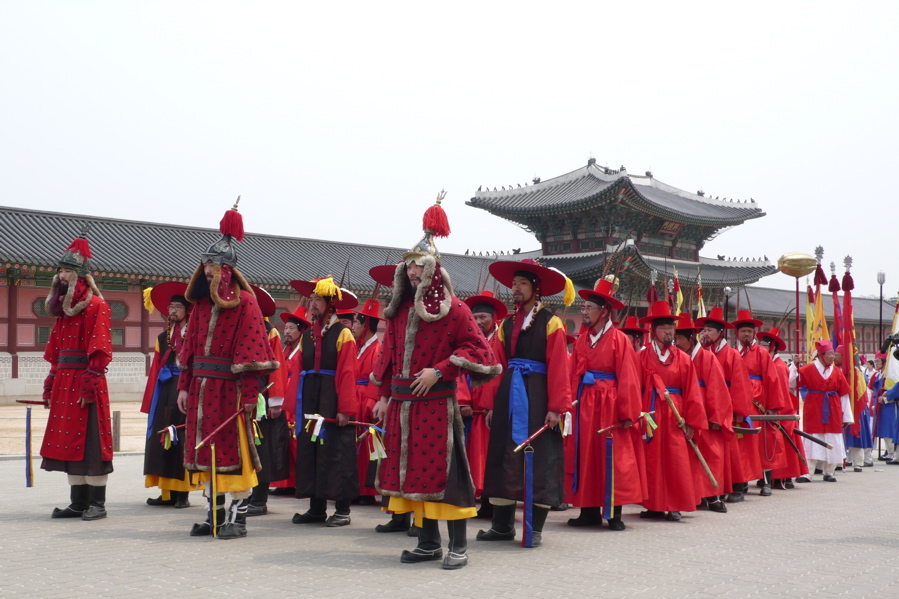
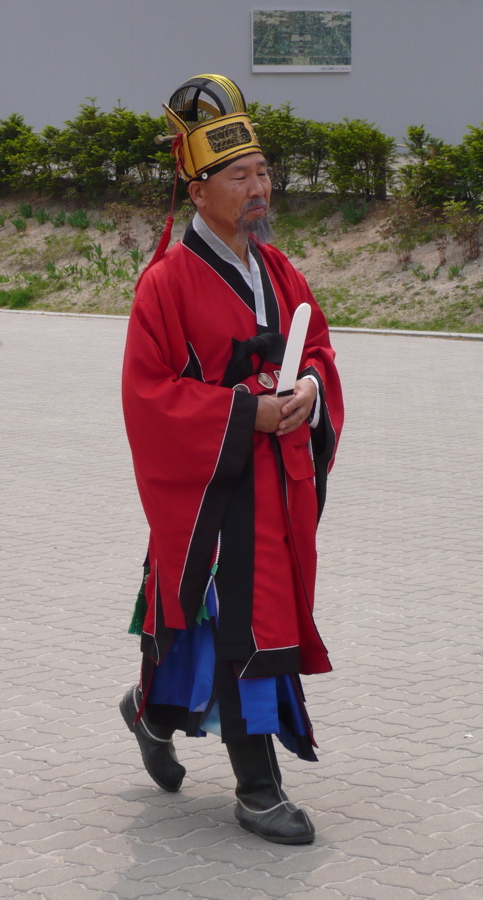
I caught this shot of the drummer just in front of the statue of General Yi Sun Shin on Sejongno opposite the Kyobo building.

Inside the shrine we watched some of the memorial service. It has eleven separate sections. The music performed during the ceremony Jongmyo Jeryeak is particularly special and was proclaimed a UNESCO Masterpiece of the Oral and Intangible Heritage of Humanity in 2001.



I caught this shot of the drummer just in front of the statue of General Yi Sun Shin on Sejongno opposite the Kyobo building.

Inside the shrine we watched some of the memorial service. It has eleven separate sections. The music performed during the ceremony Jongmyo Jeryeak is particularly special and was proclaimed a UNESCO Masterpiece of the Oral and Intangible Heritage of Humanity in 2001.

Sunday, May 06, 2007
Hi Seoul Festival High Wire championship
We saw a couple of the competitors in the Hi Seoul High Wire world championship event on Saturday morning. It was perfect weather for the final day of the three day competition: warm and bright with very little wind.
First to go was Valery Svezhov. He walked a steady pace and made it safely across the 1,000 meter long steel rope across the Han river in just over 22minutes. I caught this shot of him afterwards.

Second to go across was the Colombian Alan Martinez. He set off at a blistering pace in an attempt to surpass the target time of 11 minutes 22.49 seconds set by Abudusataer Wujiabudula of China on the first day of the event.
This is a 30 second clip of our view from the ground, of Alan 22 meters above us.
Sadly his time of 11 minutes 30.54 was just 9 seconds slower than Abusataer who remained unbeaten and went on to take the $15,000 first prize. The news stories I found did not have the full results, so here are the final results for the 15 who completed the crossing out of the 18 competitors.
First to go was Valery Svezhov. He walked a steady pace and made it safely across the 1,000 meter long steel rope across the Han river in just over 22minutes. I caught this shot of him afterwards.

Second to go across was the Colombian Alan Martinez. He set off at a blistering pace in an attempt to surpass the target time of 11 minutes 22.49 seconds set by Abudusataer Wujiabudula of China on the first day of the event.
This is a 30 second clip of our view from the ground, of Alan 22 meters above us.
Sadly his time of 11 minutes 30.54 was just 9 seconds slower than Abusataer who remained unbeaten and went on to take the $15,000 first prize. The news stories I found did not have the full results, so here are the final results for the 15 who completed the crossing out of the 18 competitors.
| Name | Country | Time |
|---|---|---|
| Abudusataer Wujiabudula | CHN | 11:22.49 |
| Alan Martinez | COL | 11:30.54 |
| Jade Kindar-Martin | USA | 11:35.54 |
| Adili Wuxiuer | CHN | 11:53.93 |
| Bekhzod Tashkenbaev | UZB | 13:02.20 |
| Laszlo Antal Simet | HUN | 14:22.45 |
| Jorge Arturo Ojeda | ECU | 14:50.41 |
| Pedro Carrillo | USA | 17:05.09 |
| Wontae Kwon | KOR | 17:06.77 |
| Tsutomu Okamoto | JPN | 17:34.86 |
| Valery Svezhov | RUS | 22:45.00 |
| Ayixiguli Maimaitimin | CHN | 31:40.58 |
| Yana Kazanbaeva | RUS | 35:23.42 |
| Olga Simet | HUN | 35:49.73 |
| Daisuke | JPN | 41:23.97 |
Friday, May 04, 2007
Jindo & Mokpo – Something Fishy
The Bat continues the narrative of our trip.
The south coast of Jindo was beautiful, but we hadn’t prepared adequately and could find no accommodation that evening i.e. there were no obvious hotel or minbak signs. It was a great disappointment but we had no choice but to head for the largest centre of population at the heart of the island. Population was exactly what we wanted to avoid, but that’ll teach us!
Waking up after our first night on Jindo (in Jindo Town), it was warm and culture was in the air. We headed off from our motel and soon found the Sojeon Art Gallery. This is a modern building in the traditional style, which houses calligraphy and ink drawings by local people. Complex Chinese characters offer huge scope for artistic expression and seem to be represented far more often than Korean or Japanese script. Scrolls of calligraphy are commonly displayed in N Asian galleries.
S Korea seems to have an excess of culture centres; these monolithic structures occur in quite unlikely settings and with curious frequency. On Jindo we saw Namdo Korean Traditional Music Center; it is so large that as we drove past it in the fading evening light we looked at each other and asked “what the heck was that ?” On the edge of Jindo Town is the Jindo Local Culture Center; it was empty when we visited Friday morning save a few staff who kindly showed us the exhibition room. There is a big culture show every Saturday, but that seems to be all.
Here is our hire car outside Jindo Culture Center

A Tolharubang ( stone grandfather ) is a cute fat thing made of volcanic rock typical of Jeju Island but much loved all over South Korea. This one stands outside the Jindo Culture Center.

Next was the Jindo Dog Research Center. The Jindo or Jindogae is a breed of dog much admired in Korea and unique to this country. It is especially loyal, intelligent and suited to (human) family life. As we approached the cages all the doggies barked and barked. There were no signs of any staff so we wandered around the cages, glanced at the dog circus area and got back in the car. I’d had such expectations. Perhaps the lesson is that visitors should check “show times” before visiting.
We decided to stay on Jindo another night as there was a calm atmosphere which we liked. We opted for a little motel which offered a good view of Jindo Bridge from the third floor. It cost the average 30,000 won and we were delighted. The view alone was worth it.
We had eaten well at a “Good Restaurant” nearby so we returned to eat exactly the same thing again. They were pleased to see us, so much so that the number of side dishes went from generous to outrageous, perhaps thirteen or more. The main dish was hair-tail fish soup. This fish is a beautiful silver ribbon 2-3 feet long and 4cm wide. It has no scales but it’s silver mantle comes away in tiny flakes when cooked giving its stew a magical aspect. It is quite expensive and a favourite in Korea where it can be bought fresh or fresh-salted. I really appreciate its delicate flavour.
We said our goodbyes to Jindo, and we headed to Mokpo on the mainland where the National Maritime Museum awaited us. The museum is well worth a visit, the quality of the building, the exhibition areas and the artefacts would make any town proud. We have found this to be true of all Korean museums visited so far, and there have been a few. From the most prestigious National Museum of Korea (Seoul) to the small, but perfectly formed, Korean Embroidery Museum, all museums seem to be blessed with ample space, light, modern fittings, toilets and (not forgetting) many fine exhibits. I can only conclude that the funding must be very generous.
Mokpo has a cluster of museums within walking distance of each other; apart from the Maritime Museum, there is a Museum of Natural History, of Industrial Ceramics and of Local History. The first two are excellent, whereas the ceramics were disappointing. We thought much more could have been made of high tech applications of ceramics – to fully reflect the “industrial” in the title and to inspire the youngsters of Mokpo in the direction of science and engineering.
Photo of the Maritime Museum
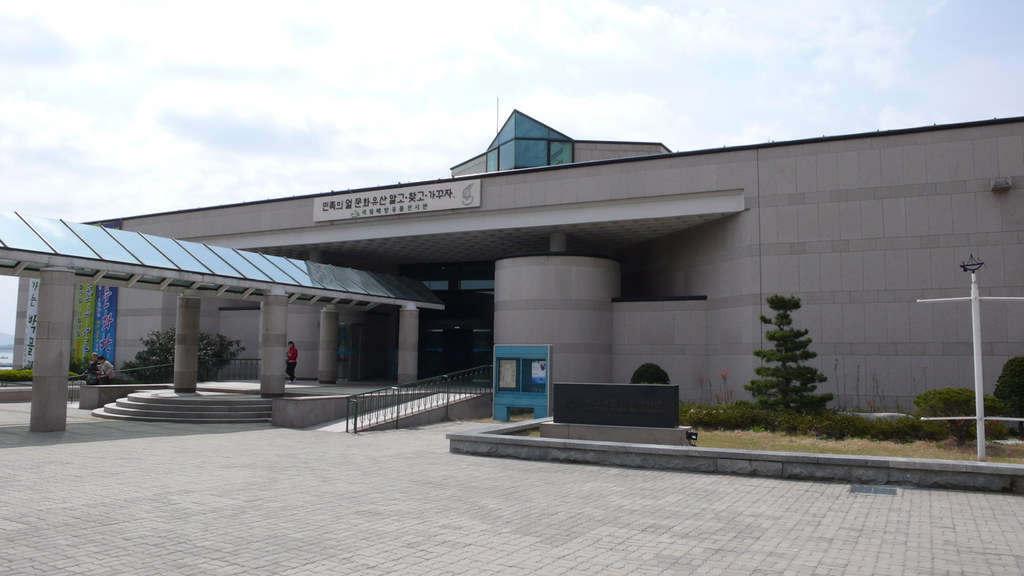
The Maritime Museum is exciting for linking maritime trade between China, Korea and Japan in centuries past. Porcelain was very important, but spices (such as black pepper), sandalwood and copper coins were also traded in volume. Korea was something of a staging post between China and Japan on this leg of the “porcelain road” – The wreck of the Shinan (1323) bound from Ningbo in China to Hakada in Japan provides evidence of this.
Model of the Shinan :

Reconstruction of the hull of the Shinan (wood preserved with PEG)
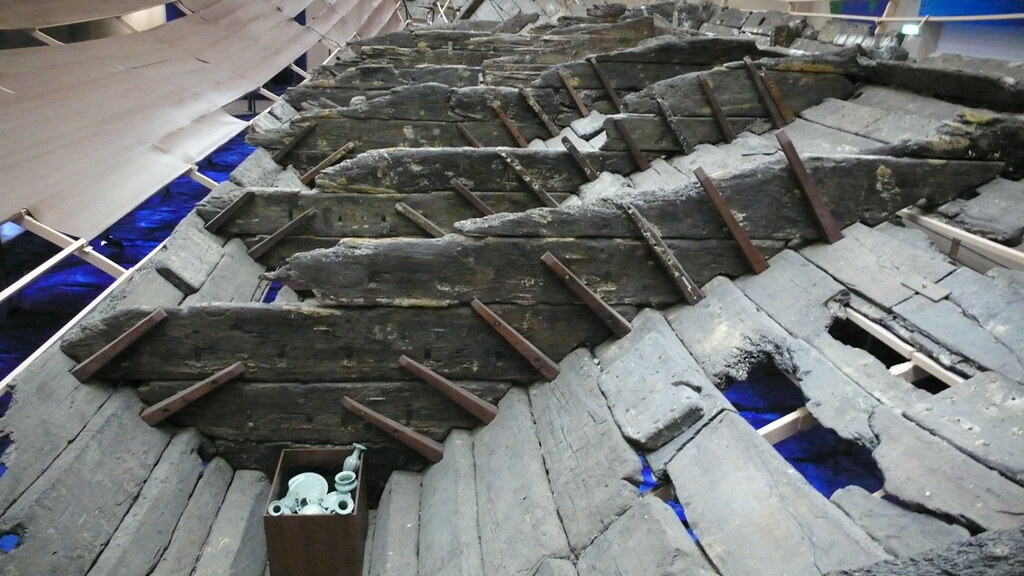
Here are some of the materials recovered from the Shinan :
Water droppers ( used for preparing ink )

Copper coins bound for Japan
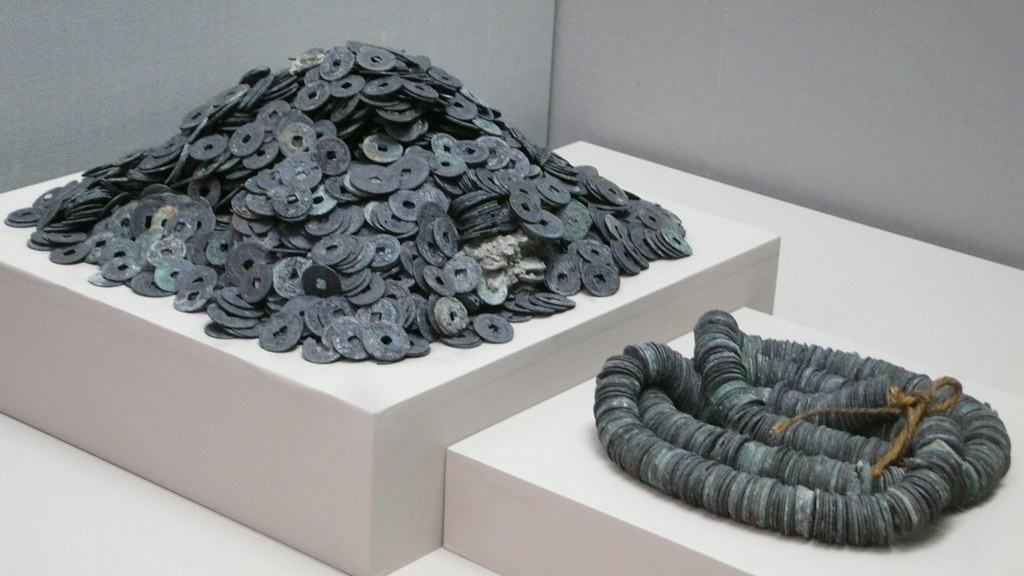
There is a great deal of material on the subject of the Maritime Silk Road, for example : ThinkQuest.org
Now it was time for a late lunch so we went into Mokpo and parked in the harbour area near the dry fish market, where the parking is free and easy. The dry fish market extends over a large area and adjoins a fresh fish area too. Like all markets, it’s a fascinating spectacle. We walked and walked, we saw many heaps of dried seaweed, dried cuttlefish, dried squid, on and on. Unfortunately the profusion of fresh and dried fish somewhat belies its cost. Raw fish for two can easily cost 100,000 won, and when you consider that a very good meal can be had here for 10,000 won ( about £5 ) it simply doesn’t make sense on our current budget. So, we settled for – er – steamed dumplings and hand cut noodles with clams at the princely sum of 6,000 won. Another bargain.
Read Part 3 here.
The south coast of Jindo was beautiful, but we hadn’t prepared adequately and could find no accommodation that evening i.e. there were no obvious hotel or minbak signs. It was a great disappointment but we had no choice but to head for the largest centre of population at the heart of the island. Population was exactly what we wanted to avoid, but that’ll teach us!
Waking up after our first night on Jindo (in Jindo Town), it was warm and culture was in the air. We headed off from our motel and soon found the Sojeon Art Gallery. This is a modern building in the traditional style, which houses calligraphy and ink drawings by local people. Complex Chinese characters offer huge scope for artistic expression and seem to be represented far more often than Korean or Japanese script. Scrolls of calligraphy are commonly displayed in N Asian galleries.
S Korea seems to have an excess of culture centres; these monolithic structures occur in quite unlikely settings and with curious frequency. On Jindo we saw Namdo Korean Traditional Music Center; it is so large that as we drove past it in the fading evening light we looked at each other and asked “what the heck was that ?” On the edge of Jindo Town is the Jindo Local Culture Center; it was empty when we visited Friday morning save a few staff who kindly showed us the exhibition room. There is a big culture show every Saturday, but that seems to be all.
Here is our hire car outside Jindo Culture Center

A Tolharubang ( stone grandfather ) is a cute fat thing made of volcanic rock typical of Jeju Island but much loved all over South Korea. This one stands outside the Jindo Culture Center.

Next was the Jindo Dog Research Center. The Jindo or Jindogae is a breed of dog much admired in Korea and unique to this country. It is especially loyal, intelligent and suited to (human) family life. As we approached the cages all the doggies barked and barked. There were no signs of any staff so we wandered around the cages, glanced at the dog circus area and got back in the car. I’d had such expectations. Perhaps the lesson is that visitors should check “show times” before visiting.
We decided to stay on Jindo another night as there was a calm atmosphere which we liked. We opted for a little motel which offered a good view of Jindo Bridge from the third floor. It cost the average 30,000 won and we were delighted. The view alone was worth it.
We had eaten well at a “Good Restaurant” nearby so we returned to eat exactly the same thing again. They were pleased to see us, so much so that the number of side dishes went from generous to outrageous, perhaps thirteen or more. The main dish was hair-tail fish soup. This fish is a beautiful silver ribbon 2-3 feet long and 4cm wide. It has no scales but it’s silver mantle comes away in tiny flakes when cooked giving its stew a magical aspect. It is quite expensive and a favourite in Korea where it can be bought fresh or fresh-salted. I really appreciate its delicate flavour.
We said our goodbyes to Jindo, and we headed to Mokpo on the mainland where the National Maritime Museum awaited us. The museum is well worth a visit, the quality of the building, the exhibition areas and the artefacts would make any town proud. We have found this to be true of all Korean museums visited so far, and there have been a few. From the most prestigious National Museum of Korea (Seoul) to the small, but perfectly formed, Korean Embroidery Museum, all museums seem to be blessed with ample space, light, modern fittings, toilets and (not forgetting) many fine exhibits. I can only conclude that the funding must be very generous.
Mokpo has a cluster of museums within walking distance of each other; apart from the Maritime Museum, there is a Museum of Natural History, of Industrial Ceramics and of Local History. The first two are excellent, whereas the ceramics were disappointing. We thought much more could have been made of high tech applications of ceramics – to fully reflect the “industrial” in the title and to inspire the youngsters of Mokpo in the direction of science and engineering.
Photo of the Maritime Museum

The Maritime Museum is exciting for linking maritime trade between China, Korea and Japan in centuries past. Porcelain was very important, but spices (such as black pepper), sandalwood and copper coins were also traded in volume. Korea was something of a staging post between China and Japan on this leg of the “porcelain road” – The wreck of the Shinan (1323) bound from Ningbo in China to Hakada in Japan provides evidence of this.
Model of the Shinan :

Reconstruction of the hull of the Shinan (wood preserved with PEG)

Here are some of the materials recovered from the Shinan :
Water droppers ( used for preparing ink )

Copper coins bound for Japan

There is a great deal of material on the subject of the Maritime Silk Road, for example : ThinkQuest.org
Now it was time for a late lunch so we went into Mokpo and parked in the harbour area near the dry fish market, where the parking is free and easy. The dry fish market extends over a large area and adjoins a fresh fish area too. Like all markets, it’s a fascinating spectacle. We walked and walked, we saw many heaps of dried seaweed, dried cuttlefish, dried squid, on and on. Unfortunately the profusion of fresh and dried fish somewhat belies its cost. Raw fish for two can easily cost 100,000 won, and when you consider that a very good meal can be had here for 10,000 won ( about £5 ) it simply doesn’t make sense on our current budget. So, we settled for – er – steamed dumplings and hand cut noodles with clams at the princely sum of 6,000 won. Another bargain.
Read Part 3 here.
Let's go Jindo
The reason for the short break in posts recently is that we took a trip out of Seoul to see more of South Korea before we leave.
To break up the long drive to the south coast we stopped in Gongju. Gongju was the capital of the Baekje Kingdom from AD 475 for 63 years before the capital was moved south to the town now known as Buyeo. Like Gyeonju the city has a number of royal tombs. King Muryeong was buried in AD523 and his tomb was undisturbed until 1971 when it was rediscovered by accident. Some of the 3,000 priceless artefacts from the tomb are on display in the Gongju National Museum. The materials and craftsmanship of the tomb objects show how advanced the Baekje Kingdom was at that time.
We visited the museum first, then walked round the hill to the actual tomb site. The tombs were sealed in 1997, to prevent deterioration of the patterned brick lining, but there is another underground museum with replicas of three of the tombs on the site. There are also some excellent models showing how the tombs were constructed.
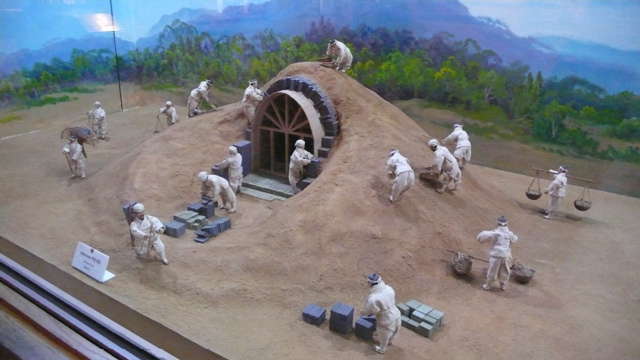
We drove to Gyeryongsan National Park to find the cherry blossom festival in full swing. However accommodation was not difficult to find and we checked into a small minbak (It's like an English Bed and Breakfast, but there is no breakfast) for 50,000 for the night. It was raining the next day, but the walk into the park to Donghaksa was still very pleasant. Dave was there recently and has some photos.
The next night we stayed at a hotel in Naejansan National Park. The 'service area' with restaurants and shops and hotels is a real eye-sore, but once we got away from that it was a very peaceful walk along the stream to the temple (Naejangsa). From there we climbed the hill to the observation point and admired the view of the valleys before descending back to the stream by cable car.
We drove on to Damyang. The Bamboo Forest attraction was more like a small amusement park with wide pathways and models of pandas, it was nearly closing time and we got in for a quick look round for free. There is a bamboo festival which runs until 5th May but we were too early to catch the start of it. We also missed The Bamboo Museum which sounded interesting.
Unable to find a hotel in town we drove on to Gwangju and ended up staying in a 'love motel', which was interesting! Only 35,000 won for a large room with huge TV, a heart shaped bed with some smelly bedding and a painting of a nude on the wall. Leaving the motel in the morning was easy, but escaping Gwangju was more difficult. The roadsigns did not indicate any routes or towns outside the city. Heading for the hills we eventually found a sign for the expressway and continued our journey south and crossed onto the island of Jindo over this suspension bridge:

We arrived in time to catch the Miracle of the Jindo sea parting. This remarkable event happens every month when at low tide the seabed is shallow enough to walk across to the tiny island of Modo 2.8km off the coast. The festival is held once or twice a year and there were hundreds of stalls selling food and local produce. There was also a stage with traditional dancing and folk performances.
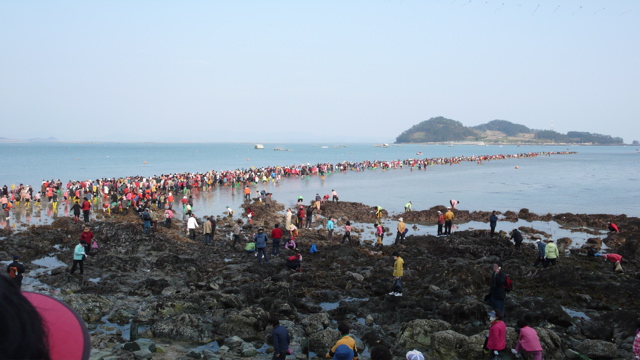
We purchased plastic wading boots, made out of the same material you make rubber gloves from, for a very reasonable 5,000 won and set out, along with the thousands of others, onto the sandy seabed. There was a real carnival atmosphere, a lot of people were busy digging for shellfish and collecting seaweed to eat, but most people were just enjoying the spectacle.
Read Part 2 here.
To break up the long drive to the south coast we stopped in Gongju. Gongju was the capital of the Baekje Kingdom from AD 475 for 63 years before the capital was moved south to the town now known as Buyeo. Like Gyeonju the city has a number of royal tombs. King Muryeong was buried in AD523 and his tomb was undisturbed until 1971 when it was rediscovered by accident. Some of the 3,000 priceless artefacts from the tomb are on display in the Gongju National Museum. The materials and craftsmanship of the tomb objects show how advanced the Baekje Kingdom was at that time.
We visited the museum first, then walked round the hill to the actual tomb site. The tombs were sealed in 1997, to prevent deterioration of the patterned brick lining, but there is another underground museum with replicas of three of the tombs on the site. There are also some excellent models showing how the tombs were constructed.

We drove to Gyeryongsan National Park to find the cherry blossom festival in full swing. However accommodation was not difficult to find and we checked into a small minbak (It's like an English Bed and Breakfast, but there is no breakfast) for 50,000 for the night. It was raining the next day, but the walk into the park to Donghaksa was still very pleasant. Dave was there recently and has some photos.
The next night we stayed at a hotel in Naejansan National Park. The 'service area' with restaurants and shops and hotels is a real eye-sore, but once we got away from that it was a very peaceful walk along the stream to the temple (Naejangsa). From there we climbed the hill to the observation point and admired the view of the valleys before descending back to the stream by cable car.
We drove on to Damyang. The Bamboo Forest attraction was more like a small amusement park with wide pathways and models of pandas, it was nearly closing time and we got in for a quick look round for free. There is a bamboo festival which runs until 5th May but we were too early to catch the start of it. We also missed The Bamboo Museum which sounded interesting.
Unable to find a hotel in town we drove on to Gwangju and ended up staying in a 'love motel', which was interesting! Only 35,000 won for a large room with huge TV, a heart shaped bed with some smelly bedding and a painting of a nude on the wall. Leaving the motel in the morning was easy, but escaping Gwangju was more difficult. The roadsigns did not indicate any routes or towns outside the city. Heading for the hills we eventually found a sign for the expressway and continued our journey south and crossed onto the island of Jindo over this suspension bridge:

We arrived in time to catch the Miracle of the Jindo sea parting. This remarkable event happens every month when at low tide the seabed is shallow enough to walk across to the tiny island of Modo 2.8km off the coast. The festival is held once or twice a year and there were hundreds of stalls selling food and local produce. There was also a stage with traditional dancing and folk performances.

We purchased plastic wading boots, made out of the same material you make rubber gloves from, for a very reasonable 5,000 won and set out, along with the thousands of others, onto the sandy seabed. There was a real carnival atmosphere, a lot of people were busy digging for shellfish and collecting seaweed to eat, but most people were just enjoying the spectacle.
Read Part 2 here.
Thursday, May 03, 2007
Hi Seoul Festival
We went to the festival stage on Sunday evening to see the 'Non verbal performance'. The drumming , the magic show and the martial arts show were excellent, but whoever booked the singer maybe needs to have the meaning of the title of the show explained to them one more time.
The lighted boats floating down the Han were very well done, look out for them between 8pm and 10pm if you get a chance. There are some more decorated boats moored beside the stage near Building 63 that caught my eye:
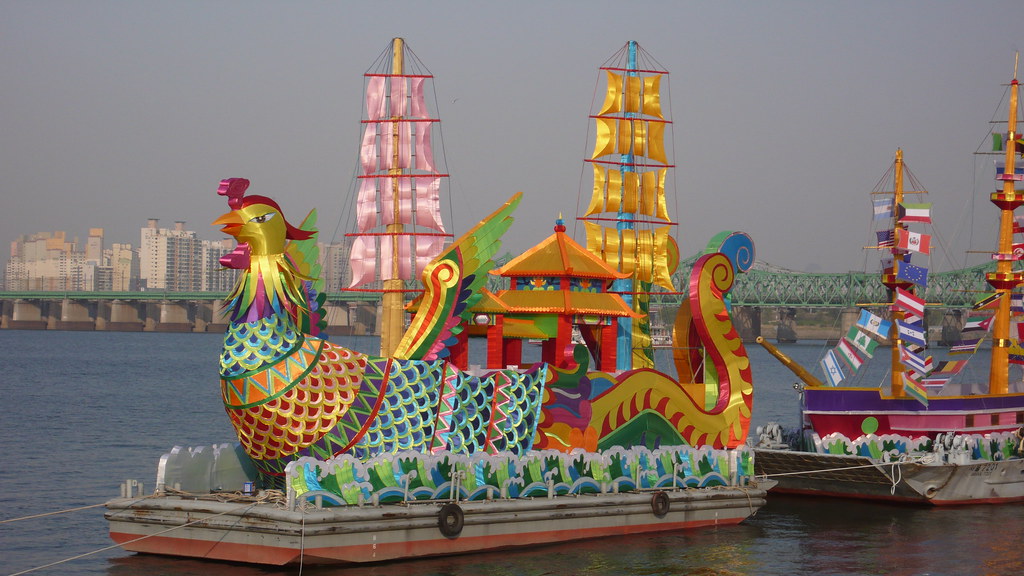
Yesterday we went back to Gyeonghuigung palace to see some more of the events. There was drumming from a very good five member group,
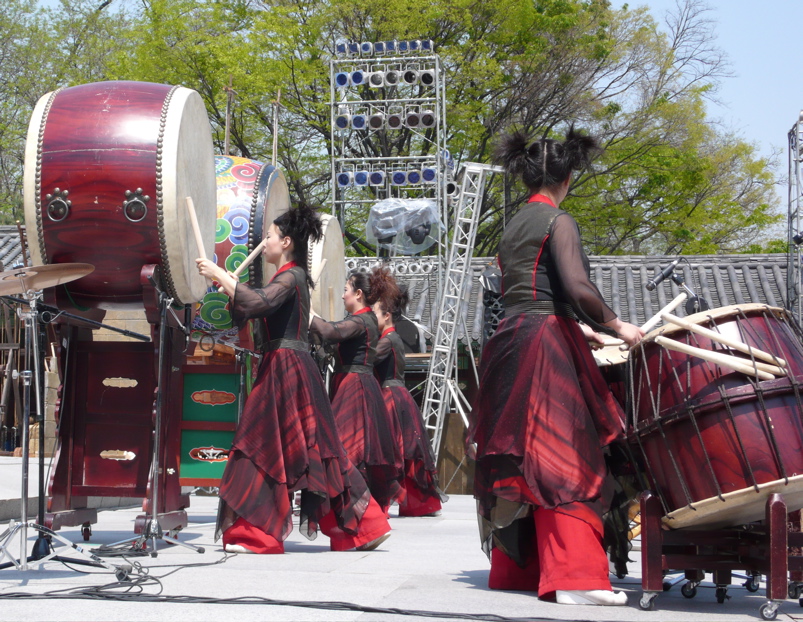
and also a superb demonstration of Taekwondo.
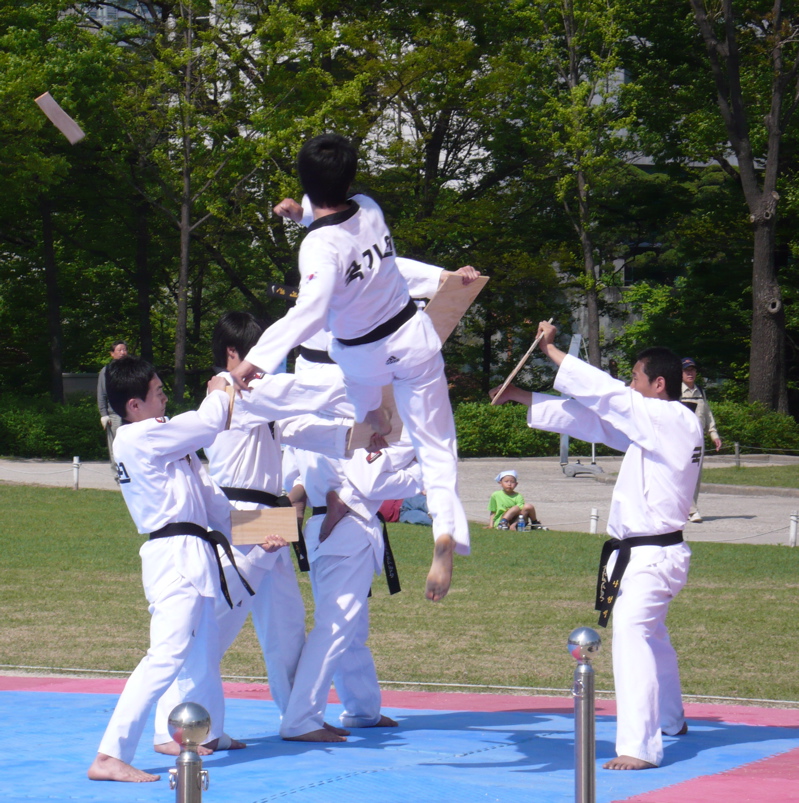
This display is repeated every Wednesday and Saturday until December at the Gyeonghuigung palace. They are also offering a Taekwondo experience for foreigners, Tuesday to Sunday every week, if you'd like to have a go yourself.
Seouliva has also been to some of the events too.
Upcoming events for the weekend are:
Friday 4th evening, the Musical Royal dream of the Hwaseong also at Gyeonghuigung palace.
on Saturday 5th: 1st Hi Wire Championship. It's also 24 Hours of flickr day, when photographers around the world are invited to share what they see on that day.
On Sunday it's the Jongmyo Daeje which only happens once a year.
The lighted boats floating down the Han were very well done, look out for them between 8pm and 10pm if you get a chance. There are some more decorated boats moored beside the stage near Building 63 that caught my eye:

Yesterday we went back to Gyeonghuigung palace to see some more of the events. There was drumming from a very good five member group,

and also a superb demonstration of Taekwondo.

This display is repeated every Wednesday and Saturday until December at the Gyeonghuigung palace. They are also offering a Taekwondo experience for foreigners, Tuesday to Sunday every week, if you'd like to have a go yourself.
Seouliva has also been to some of the events too.
Upcoming events for the weekend are:
Friday 4th evening, the Musical Royal dream of the Hwaseong also at Gyeonghuigung palace.
on Saturday 5th: 1st Hi Wire Championship. It's also 24 Hours of flickr day, when photographers around the world are invited to share what they see on that day.
On Sunday it's the Jongmyo Daeje which only happens once a year.
Subscribe to:
Posts (Atom)